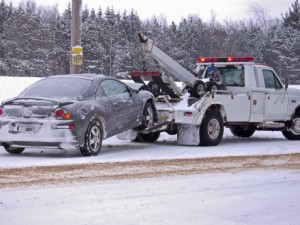 Winter weather can often prove to be treacherous for drivers, particularly those traveling along the East Coast through the New York and New Jersey metro area. Heavy winds, black ice, snow storms, freezing rain and countless other winter hazards can make traveling our states’ highways extremely risky.
Winter weather can often prove to be treacherous for drivers, particularly those traveling along the East Coast through the New York and New Jersey metro area. Heavy winds, black ice, snow storms, freezing rain and countless other winter hazards can make traveling our states’ highways extremely risky.
Drivers face a constant threat of being involved in many different types of car accidents, from a minor car fender-bender to a serious, multi-vehicle collision with serious injuries or even fatalities. What many people to do not realize is the additional risk they face immediately after a car crash has already occurred.
After a car accident, most people focus their attention on making sure all involved parties are okay, calling for medical assistance when required, documenting the accident and exchanging information for insurance purposes. These are the right things to do. The problem is, there are numerous other hazards drivers and their passengers may face after being involved in a car crash – especially during the winter.
Slipping and Falling
Roads that are wet, snowy or icy are not only difficult to navigate by car, but they are also very slippery for people on foot. After an accident, victims face the risk of slipping and falling on the cold, hard ground.
One wrong move or loss of footing, and an individual could find himself or herself suffering from injuries in addition to those sustained during the accident. According to the Centers for Disease Control and Prevention (CDC), vehicle-related accidents and falls are two of the most common types of accident resulting in serious injury or death.
Hypothermia or Frostbite
When an individual’s skin is exposed to freezing temperatures for a significant period of time, or the core temperature drops below 95 degrees, and that individual faces the risk of frostbite and hypothermia. The National Institute on Aging lists some of the early signs of hypothermia as cold feet and hands, swollen face, pale skin, acting sleepy, exhibiting confusion or unwarranted anger, and slurred speech.
Getting Hit by Another Vehicle
After the initial crash, caution must be taken to prevent you and your passengers from suffering further injuries as a result of being hit by another vehicle in a second collision.
Do not get out of your vehicle until you know it is safe to do so. In some situations, it may be safest to remain in the car until help arrives, while other times it may be safer to get out of the car.
If you get out of the vehicle, stand away from traffic when exchanging information or surveying damage. Always keep an eye on oncoming traffic so you can avoid being hit if you notice another driver beginning to lose control. Be aware of snow plows and other winter vehicles as well.
Depending on the location in which the crash took place, you may want to consider moving your vehicles to a safer location if you are able to do so. Do not attempt to move the vehicles if road conditions are too slick.
Becoming Buried under Snow
After being involved in a collision during the winter, you may have to wait for emergency personnel or a tow truck to arrive. Waiting in your vehicle is often a good idea, but be sure to put on your hazard lights so oncoming vehicles can see you. You do not want to end up being buried in your vehicle under a few feet of newly fallen snow, or as a result of a passing snow plow.
Carbon Monoxide Poisoning
If you are going to remain in your vehicle until help arrives, be sure to crack at least one window. Keeping the engine running so as to stay warm may seem like a good idea, but what you may not realize is that you could be at risk of carbon monoxide poisoning if your vehicle’s air-intake system were to get clogged by snow.
Being Prepared Can Help You Avoid Further Injury Following a Car Accident
Being properly prepared is the most effective way to avoid further injury or death following a car accident. Always dress appropriately for winter travel and be sure to put extra clothes, jackets and blankets in your car in case you break down or get into a car accident. Having at least one extra change of clothes could be key if the clothes you are wearing become wet or cold. Sitting in wet clothing, particularly wet socks, will often only make matters worse.
Pack reserve supplies of food and water. Bring a cell phone charger with you in case your phone needs to be charged. Bring an emergency first aid kid, as well as flares, light sticks and a whistle to direct rescuers to your location.
Sources:
- National Institute on Aging – Stay Safe in Cold Weather!

Leave a Reply